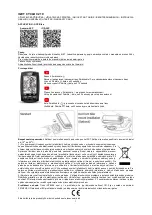
this, experiment a little by walking your bike and applying different amounts of pressure to each
brake lever, until the wheel locks.
When you apply one or both brakes, the bike begins to slow, but your body wants to continue
at the speed at which it was going. This causes a transfer of weight to the front wheel (or, under
heavy braking, around the front wheel hub, which could send you flying over the handlebars).
A wheel with more weight on it will accept greater brake pressure before lockup; a wheel with less
weight will lock up with less brake pressure.
So, as you apply brakes and your weight is transferred forward, you need to shift your body
toward the rear of the bike, to transfer weight back onto the rear wheel; and at the same time, you
need to both decrease rear braking and increase front braking force. This is even more important
on descents, because descents shift weight forward.
Two keys to effective speed control and safe stopping are controlling wheel lockup and weight
transfer. Practice braking and weight transfer techniques where there is no traffic or other
hazards and distractions.
Everything changes when you ride on loose surfaces or in wet weather. It will take longer to stop
on loose surfaces or in wet weather. Tire adhesion is reduced, so the wheels have less corner-
ing and braking traction and can lock up with less brake force. Moisture or dirt on the brake
pads reduces their ability to grip. The way to maintain control on loose or wet surfaces is to go
more slowly.
C — Motor
Gi Fly follows European regulations for electric bicycles: Gi Fly has
a 250-watt motor, is a pedelec system, and has a max speed (with
electric assistance) of 25 km/h (15 mph). If you are not located within
the European Union it is your responsibility to research the laws in
your area and be sure that you are legally permitted to ride Gi Fly in
your location.
Caution
Do not touch the motor after a long period of riding. It could be hot
and potentially burn or injure you.
Warning
Gi Fly’s max speed, with electric assistance is 25 km/h (15 mph), per
European regulations. You can exceed this max speed by pedaling
over the electric assistance. The bicycle’s electric assistance will
automatically shut down when the rider exceeds 25 km/h (15 mph).
We do not recommend that you ride faster than 25 km/h (15 mph).
Warning
52
Summary of Contents for Gi Fly
Page 1: ...Owner s Manual 1st Edition 2017 Bignay Inc...
Page 2: ......
Page 4: ......
Page 81: ...79 Img 40...
Page 82: ...80 Img 41...















































